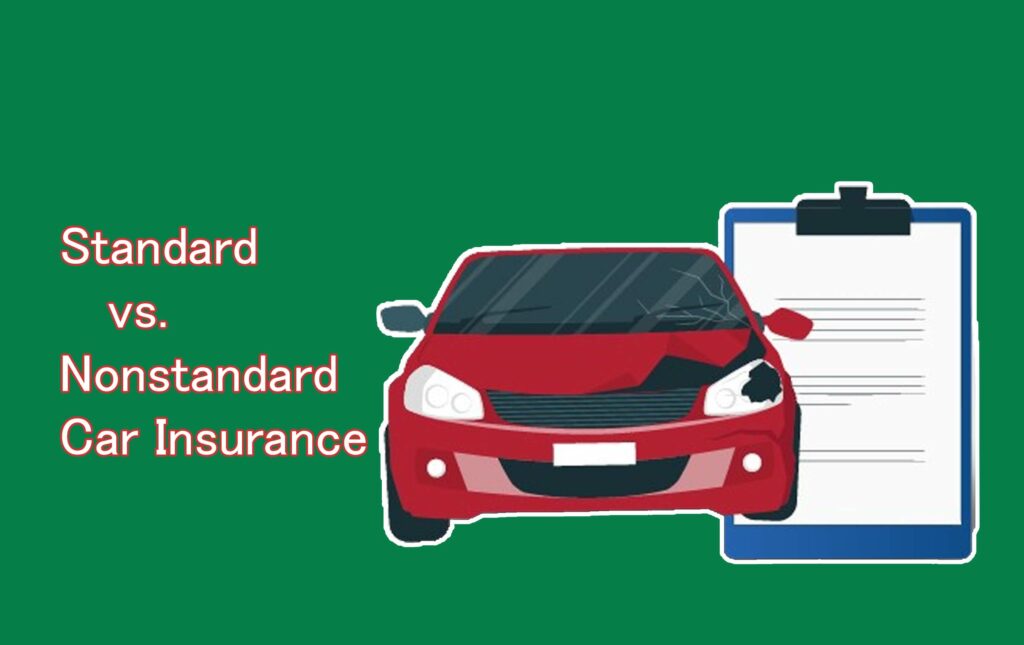Standard vs. Nonstandard Car Insurance – Car insurance is an essential financial safety net for every driver, but not all insurance policies are the same. Each driver brings a unique history to the table; from driving experience to past claims, credit score, and even the kind of vehicle they own. Insurance companies use these factors to determine risk levels and decide which type of policy best suits a driver.

This is where the distinction between standard and nonstandard car insurance becomes important. Understanding the difference between Standard vs. Nonstandard Car Insurance can help you make informed choices about your coverage and avoid paying too much for protection you either don’t need or don’t qualify for.
What Is Standard Car Insurance?
Standard car insurance is designed for drivers who are viewed as low risk by insurance companies. These are typically individuals with a good driving history, stable credit score, and no recent lapses in coverage. Because they have demonstrated responsibility on the road and in managing their insurance, these drivers are considered less likely to file claims. As a result, they are offered standard policies at affordable rates.
A standard car insurance policy includes the core coverages most drivers are familiar with — liability insurance to pay for injuries or damage you cause to others, collision coverage for damage to your own vehicle in an accident, and comprehensive coverage for non-collision losses such as theft, vandalism, or weather-related damage. It may also include medical payments and uninsured or underinsured motorist coverage.
Insurers usually provide more flexible payment options and discounts to standard policyholders. For instance, drivers with clean records might qualify for good-driver discounts, multi-car discounts, or lower premiums for completing defensive driving courses. In essence, standard car insurance is the industry’s baseline; affordable, widely available, and designed for drivers with a stable record who pose little financial risk to insurers.
What Is Nonstandard Car Insurance?
On the other hand, nonstandard car insurance caters to drivers who are considered higher risk. This group often includes people with multiple traffic violations, a history of accidents, poor credit scores, or previous lapses in insurance coverage. In some cases, new drivers with no prior insurance history may also fall into this category because insurers have limited information to assess their driving behavior.
Nonstandard policies typically come with higher premiums and fewer coverage options. Insurers charge more because these drivers are statistically more likely to file claims or be involved in accidents. For example, someone who has been caught driving under the influence or has several speeding tickets will likely be offered a nonstandard policy.
Although the cost is higher, nonstandard car insurance is still crucial. It ensures that all drivers regardless of their record; can meet state legal requirements for liability coverage and stay protected on the road. Over time, as a driver’s record improves, they may qualify to move from a nonstandard to a standard policy, gaining access to lower rates and better benefits.
Standard vs. Nonstandard Car Insurance
While both types of car insurance serve the same purpose — to provide protection — they differ in several key areas:
1. Driver Risk Profile
Standard car insurance is meant for low-risk drivers who have a good record and stable financial history. Nonstandard insurance, on the other hand, is reserved for drivers considered high risk due to past accidents, violations, or inconsistent coverage.
2. Cost of Premiums
Because standard drivers are less likely to file claims, their premiums are generally lower. Nonstandard drivers pay higher premiums because they represent a greater potential loss for the insurer.
3. Coverage Options
Standard insurance offers a wide range of coverage options and add-ons, from comprehensive protection to extras like roadside assistance. Nonstandard insurance policies are often more basic and may provide fewer choices for customization.
4. Availability of Discounts
Standard policyholders usually have access to multiple discounts, such as safe driver, multi-policy, or good student discounts. Nonstandard drivers may find these incentives limited or unavailable until their risk level improves.
5. Flexibility and Payment Plans
Insurers are more flexible with standard customers when it comes to payment schedules and renewals. Nonstandard policyholders may face stricter terms, shorter policy periods, or higher down payments.
6. Eligibility Requirements
To qualify for standard insurance, drivers must typically have a clean record and no gaps in coverage. Nonstandard policies exist specifically to serve those who do not meet these conditions ensuring that everyone, regardless of past mistakes, can remain insured.
Which Is Right for Me?
The type of car insurance that’s right for you depends on your driving record, credit score, and insurance history. If you have a clean driving record, few or no claims, and stable financial standing, then standard car insurance is your best choice. It provides broader coverage at lower rates and gives you access to discounts and flexible payment options.
However, if you’ve had accidents, traffic violations, or lapses in coverage, you may initially need nonstandard car insurance. Although it comes with higher premiums, it allows you to stay legally insured while you work on improving your record. Over time, maintaining a claim-free history, paying your premiums on time, and keeping continuous coverage can help you transition from a nonstandard to a standard policy.
It’s also important to regularly review your policy and compare quotes from multiple insurers. Some companies specialize in helping high-risk drivers find affordable coverage, while others reward good drivers with better deals. The key is to stay insured and make steady progress toward qualifying for standard rates.
Conclusion
Both standard and nonstandard car insurance serve essential roles in keeping drivers protected on the road. Standard insurance rewards responsible drivers with affordable premiums and flexible options, while nonstandard insurance ensures that even those with imperfect records remain covered and compliant with the law.
No matter which category you fall into, your insurance status isn’t permanent. With consistent effort, safe driving habits, and responsible financial management, you can improve your standing and move toward better coverage and lower costs. Ultimately, the right policy is the one that fits your current needs, helps you stay protected, and positions you for a more secure driving future.



